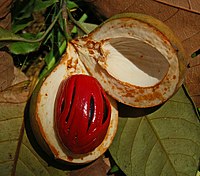
Photo from wikipedia
DNA barcoding and metabarcoding provide new avenues for investigating biological systems. These techniques require well‐curated reference libraries with extensive coverage. Generating an exhaustive national DNA barcode reference library can open… Click to show full abstract
DNA barcoding and metabarcoding provide new avenues for investigating biological systems. These techniques require well‐curated reference libraries with extensive coverage. Generating an exhaustive national DNA barcode reference library can open up new avenues of research in ecology, evolution and conservation, yet few studies to date have created such a resource. In plant DNA barcoding, herbarium collections provide taxonomically robust material but also pose challenges in lab processing. Here, we present a national DNA barcoding resource covering all of the native flowering plants and conifers of the United Kingdom. This represents 1,482 plant species, with the majority of specimens (81%) sourced from herbaria. Using Sanger sequencing of the plant DNA barcode markers, rbcL, matK, and ITS2, at least one DNA barcode was retrieved from 98% of the UK flora. We sampled from multiple individuals, resulting in a species coverage for rbcL of 96% (4,477 sequences), 90% for matK (3,259 sequences) and 75% for ITS2 (2,585 sequences). Sequence recovery was lower for herbarium material compared to fresh collections, with the age of the specimen having a significant effect on the success of sequence recovery. Species level discrimination was highest with ITS2, however, the ability to successfully retrieve a sequence was lowest for this region. Analyses of the genetic distinctiveness of species across a complete flora showed DNA barcoding to be informative for all but the most taxonomically complex groups. The UK flora DNA barcode reference library provides an important resource for many applications that require plant identification from DNA.
Journal Title: Molecular Ecology Resources
Year Published: 2021
Link to full text (if available)
Share on Social Media: Sign Up to like & get
recommendations!